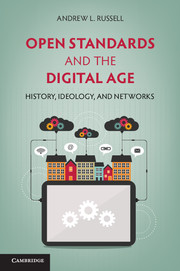Book contents
- Frontmatter
- Dedication
- Contents
- Tables and Figures
- Acknowledgments
- List of acronyms
- 1 Introduction
- 2 Ideological Origins of Open Standards I: Telegraph and Engineering Standards, 1860s–1900s
- 3 Ideological Origins of Open Standards II: American Standards, 1910s–1930s
- 4 Standardization and the Monopoly Bell System, 1880s–1930s
- 5 Critiques of Centralized Control, 1930s–1970s
- 6 International Standards for the Convergence of Computers and Communications, 1960s–1970s
- 7 Open Systems and the Limits of Democratic Design, 1970s–1980s
- 8 The Internet and the Advantages of Autocratic Design, 1970s–1990s
- 9 Conclusion
- Bibliography
- Index
- References
2 - Ideological Origins of Open Standards I: Telegraph and Engineering Standards, 1860s–1900s
Published online by Cambridge University Press: 05 June 2014
- Frontmatter
- Dedication
- Contents
- Tables and Figures
- Acknowledgments
- List of acronyms
- 1 Introduction
- 2 Ideological Origins of Open Standards I: Telegraph and Engineering Standards, 1860s–1900s
- 3 Ideological Origins of Open Standards II: American Standards, 1910s–1930s
- 4 Standardization and the Monopoly Bell System, 1880s–1930s
- 5 Critiques of Centralized Control, 1930s–1970s
- 6 International Standards for the Convergence of Computers and Communications, 1960s–1970s
- 7 Open Systems and the Limits of Democratic Design, 1970s–1980s
- 8 The Internet and the Advantages of Autocratic Design, 1970s–1990s
- 9 Conclusion
- Bibliography
- Index
- References
Summary
Americans of all ages, all conditions, and all dispositions constantly form associations. They have not only commercial and manufacturing companies, in which all take part, but associations of a thousand other kinds, religious, moral, serious, futile, general or restricted, enormous or diminutive…. Wherever at the head of some new undertaking you see the government in France, or a man of rank in England, in the United States you will be sure to find an association.
– Alexis de Tocqueville, Democracy in America, 1840Had he been able to visit America in 1900, Alexis de Tocqueville would have seen that Americans continued to “constantly form associations.” Americans continued to form commercial and manufacturing companies, as Tocqueville witnessed in the 1830s. Moreover, representatives of those companies formed additional associations to pursue common interests and ambitions. Through these combinations of associations, Americans developed technical standards to harmonize crucial aspects of industrial production.
Such voluntary industrial and corporate associations are by and large missing from histories of the late nineteenth-century American industrial economy. Histories of this era of American capitalism tend to focus on two general types of activity: disorganized and cutthroat competition in markets, and hierarchical command structures that developed within large corporations. Only recently have historians paid more attention to a third type of activity, which they conceptualize as hybrids of markets (which facilitate singular transactions) and hierarchies (which provide permanent structures for repeated transactions). William Cronon’s discussion in Nature’s Metropolis of the Chicago Board of Trade provides perhaps the best-known example of this hybrid form of coordination mechanism in the mid-nineteenth century. Cronon explains how the Board of Trade’s grading system decoupled grain ownership from its market price by creating standards of quality for different types of wheat. It thus functioned as an institution that created a level playing field for all grain merchants and prevented the possibility of control by a few powerful ones.
- Type
- Chapter
- Information
- Open Standards and the Digital AgeHistory, Ideology, and Networks, pp. 25 - 57Publisher: Cambridge University PressPrint publication year: 2014



